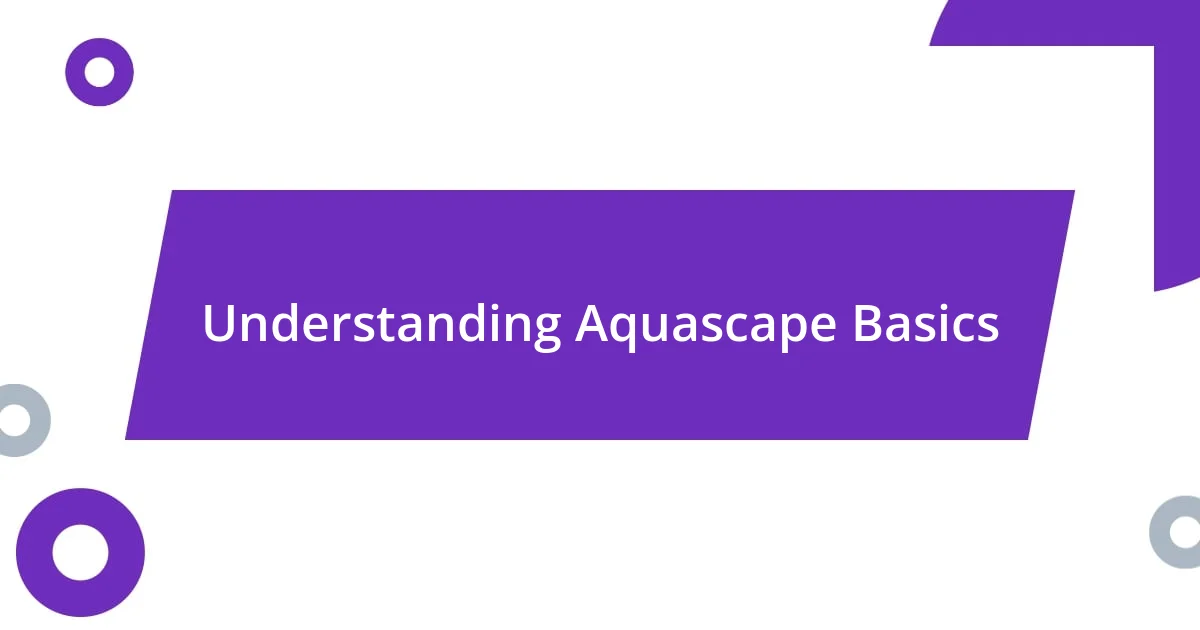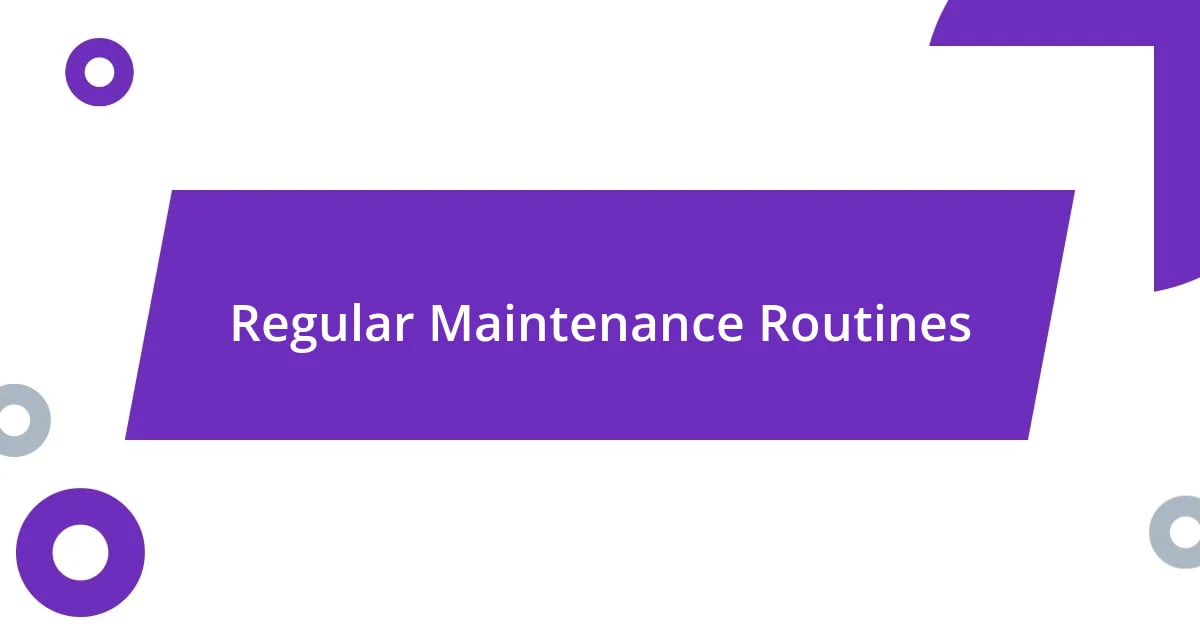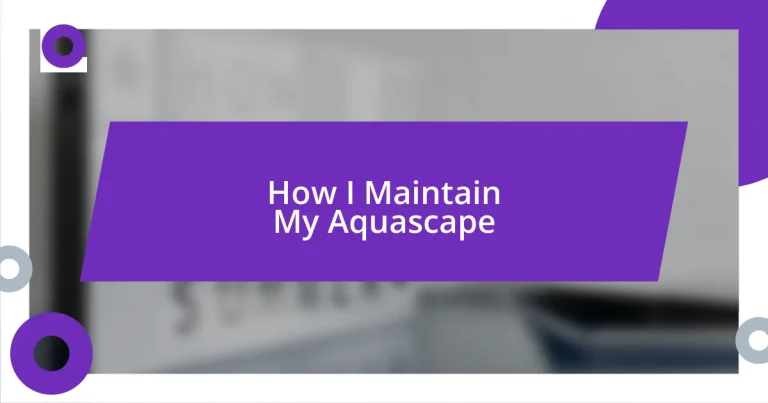Key takeaways:
- Understanding the foundational elements like light, water quality, and substrate is crucial for creating a thriving aquascape.
- Choosing compatible plants with appropriate light, growth patterns, and colors enhances the overall aesthetic and health of the ecosystem.
- Regular maintenance, including water changes and monitoring, is essential to prevent issues like algae overgrowth and nutrient deficiencies.

Understanding Aquascape Basics
When I first started my aquascaping journey, I quickly learned that understanding the foundational elements is crucial. Light, water quality, and substrate all play pivotal roles in creating a thriving aquatic environment. Have you ever noticed how the right lighting can bring out the vibrant colors in plants? That’s not just a coincidence; it’s all about finding that perfect balance.
I remember setting up my first aquascape and being utterly fascinated by the variety of plants available. Each type requires different care, from low-light ferns to demanding carpeting plants. It made me wonder—how can a newcomer navigate all these choices? The key lies in researching and understanding your desired ecosystem; it’s about choosing plants that thrive together.
Water parameters are another critical factor that often goes overlooked. A few months into my aquascaping hobby, I faced a mini-crisis when my fish began showing signs of stress. Testing my water revealed that the pH was off. This experience taught me that regular testing and adjustments are not just tedious tasks; they are vital for maintaining harmony in your aquascape. Have you checked your water recently? It might reveal more than you think!

Choosing the Right Plants
Choosing the right plants for your aquascape can feel overwhelming, especially with the vast array available. I remember spending hours at my local aquarium store, just gazing at the lush displays. It struck me how certain plants seemed to complement each other, enhancing the overall beauty of the tank. To achieve a harmonious look, I always consider the plant’s size, growth rate, and lighting needs. You want to create balance—not just visually but also in terms of their care requirements.
Here are some tips for selecting the right plants:
- Light Requirements: Match the plants to your lighting setup; low-light plants like Java fern thrive in less light, while high-light species like Glossostigma require more attention.
- Growth Patterns: Consider how tall or wide plants will grow. I learned this the hard way when a once-small Cryptocoryne took over, crowding out my carefully arranged foreground plants.
- Compatibility: Think about how plants interact. Some like to spread wide and will outcompete others for nutrients, which can lead to an imbalanced ecosystem.
- Color and Texture: Choose plants that offer a variety of colors and textures. Adding a splash of red or a soft fern can create visual interest and dimension, making your aquascape feel more alive.
- Personal Preference: Ultimately, choose what you love. I still remember the joy of planting my first Anubias; its unique shape and hardiness captured my heart, and it still holds a special place in my tank.

Setting Up a Balanced Ecosystem
Setting up a balanced ecosystem is a nuanced endeavor that I’ve come to appreciate more as I’ve gained experience. The relationship between plants, fish, and bacteria forms a delicate web of interactions, and understanding these is essential. For instance, when I added a few shrimp to my tank, I noticed how they helped control algae naturally, contributing to the balance. They became my little cleanup crew! Have you considered how different species interact in your ecosystem?
One important aspect I learned is the need for proper cycling. Initially, I rushed to add fish without allowing the beneficial bacteria to grow. The result? An ammonia spike that stressed my fish. Now, I always cycle my tank for several weeks, allowing the nitrifying bacteria to establish themselves before introducing any new aquatic life. It’s a lesson in patience that pays off with a healthier aquascape.
Creating a balanced ecosystem also requires consistent monitoring. I check my water parameters regularly to ensure everything is in check. There was a time when fluctuations in nitrate levels caused my plants to struggle, and it was disappointing to see them wilt. By being proactive and adjusting my maintenance routine, I’ve found that my plants and fish thrive harmoniously. So, how do you monitor your ecosystem’s health? Finding the right balance might just be the key to a flourishing aquascape!
| Element | Importance |
|---|---|
| Light | Encourages plant growth and photosynthesis |
| Water Quality | Affects fish health and plant vitality |
| Beneficial Bacteria | Helps break down waste products, maintaining water balance |

Regular Maintenance Routines
Regular maintenance is crucial for keeping my aquascape thriving, and I focus on a few key routines. Every week, I set aside some time to perform a water change—this simple act really makes a difference! I vividly remember the first time I neglected this; my plants looked dull and sluggish. Now, after a fresh water change, I watch them perk up, almost as if they’re thanking me.
I also devote a couple of minutes daily to observe my tank and its inhabitants. It sounds simple, but this practice has become a meditative part of my routine. I enjoy watching my fish swim joyfully, while I evaluate the growth of my plants. It allows me to catch any potential issues early on. When was the last time you really looked at your aquascape? You might be surprised by what you notice!
Lastly, I keep a maintenance log to track my tasks—like trimming, fertilizing, and testing water parameters. At first, I thought this was overkill, but now I see how beneficial it is. One month, I discovered my CO2 levels were dipping, which I might have missed without my notes. It’s amazing how a little organization can lead to a flourishing environment, don’t you think?

Troubleshooting Common Issues
One of the most common issues I’ve faced is algae overgrowth. I remember staring at my tank one day, shocked to find my beautiful plants hidden beneath a thick layer of green fuzz. It prompted me to dive deeper into understanding my light duration and intensity. Now, I keep my lights on for a maximum of eight hours a day and integrate floating plants to diffuse some of that light. Have you ever adjusted your lighting to tackle stubborn algae?
Another challenge has been nutrient deficiencies in my plants. Early on, I noticed yellowing leaves and stunted growth, which was a clear sign something wasn’t right. After some research, I realized my aquarium lacked essential fertilizers. I began using a liquid fertilizer weekly and even added root tabs for my heavier-rooted plants. Seeing them rejuvenate and grow beautifully fills me with joy each time—have you ever watched your plants flourish and made you feel accomplished?
Water parameter fluctuations can be a real headache, and I learned this the hard way. During one particularly busy month, I neglected my testing routine and ended up with a spike in nitrate levels, which stressed my fish. It was heartbreaking to see them struggle. Now, I set reminders in my phone to test my water regularly, ensuring everything stays stable. Trust me, a little diligence goes a long way in maintaining a thriving aquascape. Have you experienced a “wake-up call” moment like this in your tank maintenance journey?

Enhancing Aesthetic Appeal
Enhancing the aesthetic appeal of my aquascape is truly an art form that takes time and consideration. I’ve found that incorporating a diverse range of textures and colors not only captivates the eye but also creates a narrative within the tank. For instance, I added vibrant red plants alongside lush green ones, and the contrast is nothing short of stunning. Have you noticed how certain combinations can transform an ordinary setup into an extraordinary one?
One of my favorite enhancements is the use of hardscape materials like driftwood and stones. Each piece tells a story, from those twisted branches that remind me of ancient forests to the smooth pebbles that mimic riverbeds. Every time I rearrange these elements, I experience a renewed sense of excitement—as if I’m unveiling a new chapter in my aquascape journey. Have you ever had a moment when moving a single rock changed the entire feel of your tank?
I also ensure that my aquascape maintains a sense of balance and flow. This involves carefully planning the layout and positioning my plants so that they draw the eye through the tank, almost like a visual path. I remember once experimenting with a pyramid layout, which created beautiful layers and depth. Seeing my fish dart through these natural pathways brings me so much joy—it’s like watching a choreographed dance! Can you recall a time when a little planning dramatically improved the aesthetic of your aquascape?














